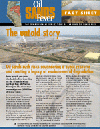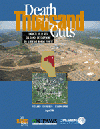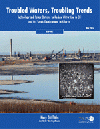$ 123,476,964
 Read Dan Woynillowicz's (of Pembina) article: Tar Sands Fever in the Sep/Oct issue of World Watch Magazine. |
Publications
Refine Publication Search
Presentation to the Multi-stakeholder Committee Re: Deep Oil SandsPeace River, Sept 14, 2006

Published: Sep 14, 2006 By: Simon Dyer Most of Alberta's oil sands are too deep to mine. Oil must be extracted using other methods that result in a dense network of roads, wells and pipelines throughout the forests of Alberta. Deep oil sands extraction could potentially impact 21% of Alberta. Simon Dyer represented the Pembina Institute at a oil sands consultation meeting in Peace River where he outlined the impacts of and proposed solutions for deep oil sands development. Publication Type: Letters & Formal Submissions, Presentations Topic Area: Oil Sands Presentation to the Oil Sands Multi-stakeholder Committee Re: Water UseBonnyville, September 13, 2006

Published: Sep 13, 2006 By: Mary Griffiths As lead author of the Pembina Institute's report Troubled Waters, Troubling Trends, Dr. Mary Griffiths represented Pembina in the first of a series of province-wide public input sessions on oil sands development. Griffiths highlighted some of the issues relating to the use of fresh water for oil sands extraction. Publication Type: Letters & Formal Submissions, Presentations Topic Area: Oil Sands 
Published: Aug 23, 2006 By: Dan Woynillowicz This fact sheet provides an overview of key facts and figures from The Pembina Institute's book Oil Sands Fever: The Environmental Implications of Canada's Oil Sands Rush produced in 2005. Publication Type: Briefing Notes, Summaries & Fact Sheets Topic Area: Oil Sands 
Published: Aug 1, 2006 By: Simon Dyer The Pembina Institute's new book Death by a Thousand Cuts: The Impacts of In Situ Oil Sands Development on Alberta's Boreal Forest examines the environmental impacts of in situ (in place) development of deep oil sands that has the potential to affect a forested region 50 times larger than the areas leased for oil sands mining north of Fort McMurray. Publication Type: Reports, Backgrounders & Position Papers Topic Area: Oil Sands Published: Aug 1, 2006 By: Simon Dyer The Pembina Institute's new book Death by a Thousand Cuts: The Impacts of In Situ Oil Sands Development on Alberta's Boreal Forest examines the environmental impacts of in situ (in place) development of deep oil sands that has the potential to affect a forested region 50 times larger than the areas leased for oil sands mining north of Fort McMurray. This document accompanies the report, and provides an overview of key facts and figures. Publication Type: Briefing Notes, Summaries & Fact Sheets Topic Area: Oil Sands 
Published: Aug 1, 2006 By: Pembina Institute Death by a Thousand Cuts is an interactive Flash movie featuring over-flights of the massive oil sands developments in northern Alberta. Shot on the ground and from the air north and south of Fort McMurray, this interactive movie shows and explains the oil sands mining operations north of Fort McMurray and the larger deep oil sands in situ operations from the air. Oil sands mining leases already cover 3,000 km2 of boreal forest; the in situ deep oil sands operations could cover 21 % of Alberta if all leases are sold. Publication Type: Reports, Backgrounders & Position Papers Topic Area: Oil Sands Albertans' Perceptions of Oil Sands Development Poll Part 2: Environmental Issues

Published: May 30, 2006 By: Simon Dyer The Pembina Institute commissioned Probe Research Inc. to conduct a study to gauge public attitudes towards the environmental and economic impacts of oil sands development in Alberta and to identify the roles and responsibilities of the public and private sectors involved in oil sands development. Publication Type: Reports, Backgrounders & Position Papers Topic Area: Oil Sands Albertans' Perceptions of Oil Sands Development PollPart 1: Economic Issues

Published: May 30, 2006 By: Simon Dyer The Pembina Institute commissioned Probe Research Inc., a professional research and survey organization based in Winnipeg, Manitoba, to conduct a study among Alberta adults. The purpose of the study was to gauge public attitudes towards the environmental and economic impacts of oil sands development in Alberta and to ascertain Albertans' understanding and expectations regarding the roles and responsibilities of the public and private sectors involved in oil sands development. Publication Type: Reports, Backgrounders & Position Papers Topic Area: Oil Sands 
Published: May 1, 2006 By: Mary Griffiths, Amy Taylor, Dan Woynillowicz Oil sands mining and steam injection, to produce oil from bitumen that is too deep to mine, currently use vast amounts of water from rivers and groundwater. Rapid expansion in tar sands production means new technology and policies described in the report must be implemented to reduce water use. Publication Type: Reports, Backgrounders & Position Papers Topic Area: Oil Sands 
Published: May 1, 2006 By: Mary Griffiths, Amy Taylor, Dan Woynillowicz Oil sands mining and steam injection, to produce oil from bitumen that is too deep to mine, currently use vast amounts of water from rivers and groundwater. Rapid expansion in tar sands production means new technology and policies described in the report must be implemented to reduce water use. Publication Type: Reports, Backgrounders & Position Papers Topic Area: Oil Sands Published: Mar 15, 2006 By: Dan Woynillowicz, Chris Severson-Baker Down to the Last Drop is the first in a series of issue papers examining the environmental implications of Canada's oil sands operations. The report authors examine Alberta Environment's recently released plan for managing water withdrawals from the Athabasca River and concludes that it does not protect the river from long-term ecological impacts due to oil sands development. Publication Type: Reports, Backgrounders & Position Papers Topic Area: Oil Sands
|
|



 Pembina's Oil Sands publications are available here. You can refine your search by clicking Refine Publication Search below.To access Pembina's full directory of publications go to Pembina's publications page.
Pembina's Oil Sands publications are available here. You can refine your search by clicking Refine Publication Search below.To access Pembina's full directory of publications go to Pembina's publications page.
